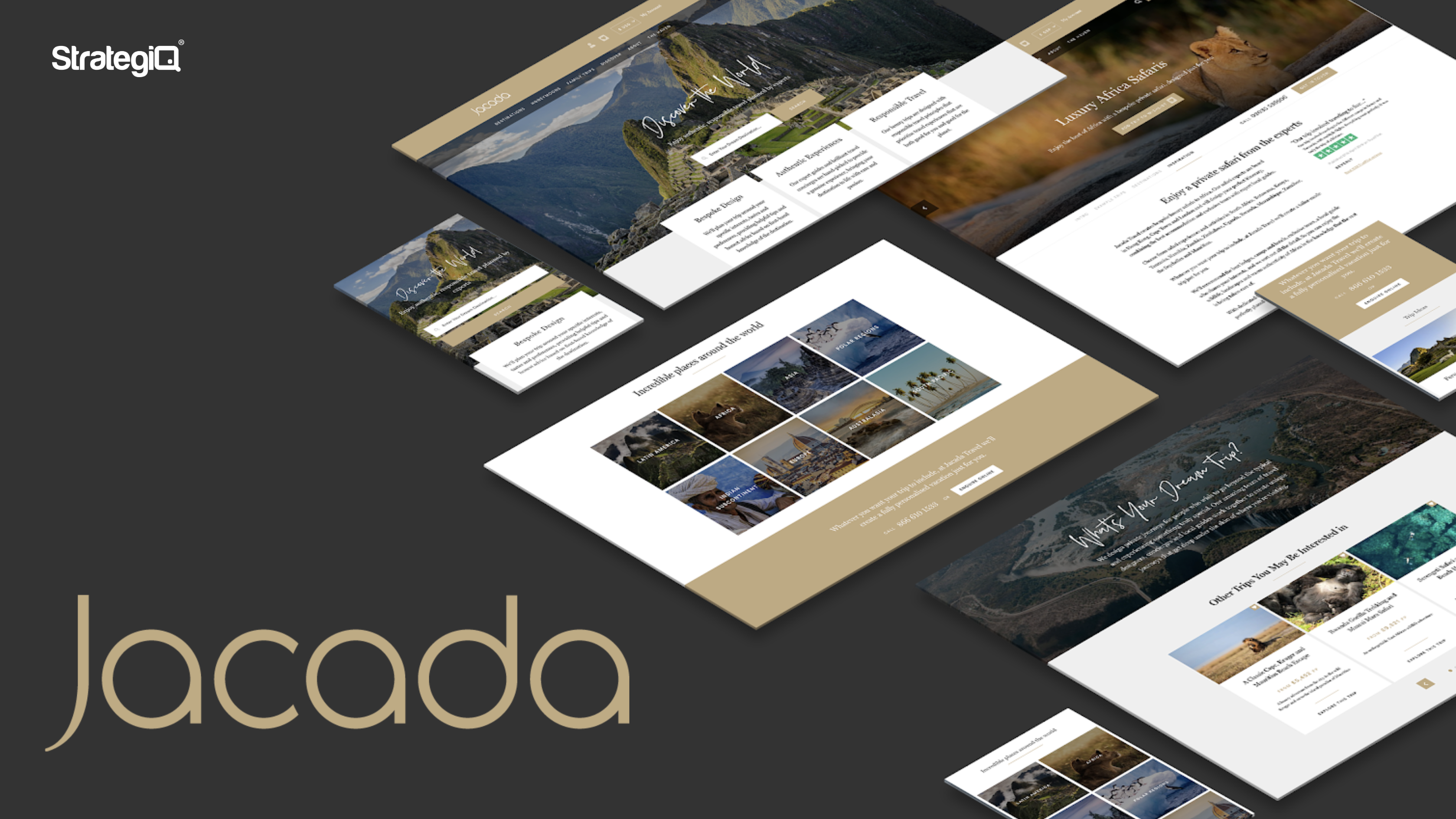Critical thinking is central to the way we work at StrategiQ. If we didn’t take time to assess the merits and drawbacks of a certain approach, or consider alternative approaches, we wouldn’t be doing justice to ourselves or our clients. After all, why employ an expert team of marketers, designers and web developers if you’re not going to utilise their expertise at every opportunity?
Our design team – myself included – are big proponents of the Six Thinking Hats method of critical thinking.
Devised by the Maltese psychologist and physician Edward de Bono in 1985, the method challenges all of us to look at projects from six different perspectives, which de Bono coined his “six hats”. Each hat represents a different way of thinking, and by wearing each hat at certain stages of the creative process, it allows us to make better decisions. That’s the theory, anyway!
To give you an idea of how we employ the Six Thinking Hats method at StrategiQ, I thought I’d use one of our clients – Jacada Travel – as an example.
We were recently tasked with redesigning Jacada’s Example Trips pages, which provide travellers with suggested itineraries for selected countries or regions around the world.
In order to deliver something that delighted the client, we needed to evaluate what didn’t work with the existing pages, analyse data on traffic and user engagement, and work through a number of concepts for the new design.
With that in mind, here is how the Six Hats Theory shaped the project from discovery and initial designs through to development and deployment.
White Hat 
White Hat thinking is concerned with gathering and analysing information that is either known or needed. When wearing this hat, your primary focus will be “the facts, just the facts.” It is about identifying what information you already have, what information is missing, what information you need to have, and how you are going to get that information. There will also be a consideration of what the information is telling you, or what you can learn from it.
How we applied it
We drew on the data we had available in Google Analytics and Hotjar to identify any quick fixes for Jacada’s Example Trips pages. These included the addition of close buttons to pop-ups that were missing them, as well as other assets to help users continue their journey through the site once they had completed an enquiry form or visited the contact page.
We also gathered some qualitative feedback from Jacada’s customers and travel designers to inform our thought process. While we didn’t agree with a couple of the suggestions, it was still a key part of the fact-finding phase and gave us much to consider as we moved forward. There was a large element of red hat thinking here too, as we let the Jacada team share their feelings without any need for explanation or apology.
Yellow Hat 
When wearing the Yellow Hat, your focus is primarily on the benefits of an idea or approach. It brings a more optimistic perspective that explores the positives and inherent value in what is being proposed. This type of thinking is important in times of difficulty and ultimately serves as the counterpoint to Black Hat thinking. It helps remind us of the “good things”.
How we applied it
There were obvious benefits to the changes agreed as part of our initial fact find, such as visitors staying on the Jacada site for longer and generally having a better user experience. We also identified the many things that were already working well on the Example Trips pages. It was evident, for example, that users were really engaging with the hero carousel and appeared to respond well to inspirational imagery.
We also saw an opportunity to optimise on-page content using the information available in JAM, Jacada’s CRM system. After pulling out the top-level key pieces of information that were unique to each trip, such as locations, airports, and activities, we attributed identifiable elements to each asset so that it was easily replicated across the 500 example trips.
Black Hat
The Black Hat is effectively the Devil’s Advocate – by highlighting the negatives and what could go wrong, it brings a necessary sense of caution or realism. It helps identify the weaknesses in a plan, allowing you to eliminate them before putting it into action. As alluded to above, black hat thinking is a “reality check” that offsets the optimism of the yellow hat.
How we applied it
Originally, as part of ongoing improvements to the site, we had proposed replacing the two-column contact form with a single-column layout. We completed an A/B test to put our hypothesis to the test and were all surprised to be proven wrong: the two-column layout had outperformed the single column layout. The initial enhancements we had made to the form – such as adding in clearer headings and a more prominent CTA – had done the trick.
From there, we made further enhancements to the two-column layout, safe in the knowledge that it was the best approach. The activity demonstrated the value of questioning and testing an alternative before putting it into action. Essentially, if we hadn’t donned our black hat, we would have ended up making the wrong decision.
Red Hat 
The Red Hat deals with feelings and emotions. It encourages the wearer to express any likes, dislikes, loves and hates, and to look at situations based purely on their own intuition or gut reaction. People wearing the red hat aren’t required to offer any reasoning or apology for the way they feel – it allows them to share their feelings free from judgement.
How we applied it
Instinctively we knew the lack of alternative example trips at the end of a page was a glaring omission. In effect, the user came to a ‘dead end’ and was unable to explore other options. Similarly, the end of a trip didn’t feel very definitive; there was no H2 within the contact form to affirm to the user that the itinerary is complete. To address this, we inserted an image asset overlaid with a large heading, so the user knew they had finished reviewing the itinerary.
Along the journey, both StrategiQ and Jacada were involved in evolving other on-page elements, such as buttons. We felt the contrast was not sufficient in certain areas, but we were equally conscious of the need to stay on brand. This was achieved by darkening the buttons in contact forms while not straying too far from Jacada’s distinctive colour palette.
Green Hat
The Green Hat brings a creative element to discussions. It is focused on exploring new possibilities, approaches and ideas – thinking outside the box and devising creative solutions to problems. Green hat wearers favour provocation and investigation; they take the opportunity to look into alternative concepts, but without criticising pre-existing ideas.
How we applied it
As well as looking at Jacada’s direct competitors to see how they were handling information and certain assets on their page layouts, we also took inspiration from other websites that were unrelated to Jacada’s industry.
In addition to this, we devised new ways of creating areas of information that were unique to each trip, but which were powered by a systematic framework. A good example of this is the Google Maps component that shows destination pins for each Example Trip and follows the user down the page as part of the sticky side navigation.
Blue Hat
The Blue Hat effectively manages or moderates the thinking process – it is generally worn by the person chairing a meeting. It determines the subject and goal of the discussion, reviews progress, and ensures the Six Thinking Hats guidelines are observed. The Blue Hat can get the thinking process back on track – if ideas have run dry, they can move towards Green Hat thinking. Alternatively, if contingency plans are needed, it can turn to the Black Hat.
How we applied it
Since deployment we have started to review the impact of the work we carried out for Jacada. This has involved looking at Hotjar recordings to see if there is anything further we can improve or have missed. We have also been through a smaller version of our standard debriefing process, allowing us to evaluate the project from various perspectives.
Do you practice Six Thinking Hat methodology in your business? If not, I hope this article has given you some food for thought. For more information, or if you’d like to share your comments on the blog, feel free to email me at becky@strategiq.co.
Alternatively, please don’t hesitate to get in touch if you’d like to learn more about our web design services.







